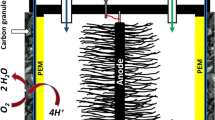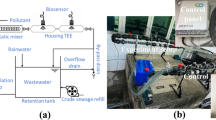Abstract
In this study, a dual-chamber microbial fuel cell (MFC) fed with actual potato chips’ processing wastewater (PCPW) was tested as a biosensor. The performance of MFC-based biosensor was evaluated in terms of the current measurement range, toxicity detection and sensitivity, and the operational stability. The results revealed that the MFC can simply be converted to an online biosensor unit to detect the harmful effect of suspended solids and acidic content in the actual PCPW on the anodic attached biofilm and the values of the generated current as well. A notable decrease in the current values was observed indicating the adverse effects of the harmful matters in the PCPW fed to the biosensor unit. The results proposed a competition between the harmful components and the favorable substrate in binding to the redox complex. An excellent fitting was obtained between the experimental and predicted results by \( I_{{K_{m} }} \) model with determination coefficient (R2) and mean-square-error values of 0.927 and 0.363, respectively. Additionally, a new approach was developed based on direct measurement of actual field data to replace the conventional statistical methods.







Similar content being viewed by others
Change history
27 August 2021
A Correction to this paper has been published: https://doi.org/10.1007/s42768-021-00078-9
References
Logan BE, Hamelers B, Rozendal R, et al. Microbial fuel cells: methodology and technology. Environ Sci Technol. 2006;40:5181–92.
Feng Y, Kayode O Jr, Harper WF. Using microbial fuel cell output metrics and nonlinear modeling techniques for smart biosensing. Sci Total Environ. 2013;449:223–8.
Stein NE, Hamelers HV, Buisman CN. Stabilizing the baseline current of a microbial fuel cell-based biosensor through overpotential control under non-toxic conditions. Bioelectrochemistry. 2010;78:87–91.
Lvars-Barceló F, Zuliani A, Fallah M, et al. Novel applications of microbial fuel cells in sensors and biosensors. Appl Sci. 2018;8:1184–99.
Gil GC, Chang IS, Kim BH, et al. Operational parameters affecting the performance of a mediator-less microbial fuel cell. Biosens Bioelectron. 2003;18:327–34.
Chang IS, Moon H, Jang JK, et al. Improvement of a microbial fuel cell performance as a BOD sensor using respiratory inhibitors. Biosens Bioelectron. 2005;20:1856–9.
Grattier M, Minteer SD. Self-powered biosensors. ACS Sens. 2017;5:44–53.
Karube I, Matsunaga T, Mitsuda S, et al. Microbial electrode BOD sensors. Biotechnol Bioeng. 1977;19:1535–47.
Liu Z, Liu J, Zhang S, et al. Microbial fuel cell based biosensor for in situ monitoring of anaerobic digestion process. Bioresour Technol. 2011;102:10221–9.
Stein NE, Keesman KJ, Hamelers HV, et al. Kinetic models for detection of toxicity in a microbial fuel cell based biosensor. Biosens Bioelectron. 2011;26:3115–20.
Shen YJ, Lefebvre O, Tan Z, et al. Microbial fuel-cell-based toxicity sensor for fast monitoring of acidic toxicity. Water Sci Technol. 2012;65:1223–8.
Stein NK, Hamelers HVM, Straten GV, et al. Effect of toxic components on microbial fuel cell-polarization curves and estimation of the type of toxic inhibition. Biosensors. 2012;2:255–68.
Chen Z, Niu Y, Zhao S, et al. A novel biosensor for p-nitrophenol based on an aerobic anode microbial fuel cell. Biosens Bioelectron. 2016;85:860–8.
Jia H, Yang G, Ngo HH, et al. Enhancing simultaneous response and amplification of biosensor in microbial fuel cell-based upflow anaerobic sludge bed reactor supplemented with zero-valent iron. Chem Eng J. 2017;327:1117–27.
Zhou S, Huang S, Li Y, et al. Microbial fuel cell-based biosensor for toxic carbon monoxide monitoring. Talanta. 2018;186:368–71.
Schievano A, Colombo A, Cossettini A, et al. Single-chamber microbial fuel cells as on-line shock-sensors for volatile fatty acids in anaerobic digesters. Waste Manage. 2018;71:785–91.
Jiang Y, Liang P, Huang X, et al. A novel microbial fuel cell sensor with a gas diffusion biocathode sensing element for water and air quality monitoring. Chemosphere. 2018;203:21–5.
Yi Y, Xie B, Zhao T, et al. Effect of external resistance on the sensitivity of microbial fuel cell biosensor for detection of different types of pollutants. Bioelectrochemistry. 2019;125:71–8.
Malladi B, Ingham SC. Thermophilic aerobic treatment of potato processing wastewater. World J Microbiol Biotechnol. 1993;31:426–8.
Davis M, Cornwell D. Introduction to environmental engineering. New York: McGraw-Hill; 1999.
Huang LP, Jin B, Lant P. Direct fermentation of potato starch wastewater to lactic acid by Rhizopus oryzae and Rhizopus arrhizus. Bioprocess Biosyst Eng. 2005;27:229–38.
Hamelers HV, Ter Heijne A, Stein N, et al. Butler–Volmer–Monod model for describing bio-anode polarization curves. Bioresour Technol. 2011;102:381–7.
Bisswanger H. Enzyme kinetics principles and methods. Hoboken: Wiley-VCH Verlang GmbH; 2008.
Kim M, Hyun MS, Gadd GM, et al. A novel biomonitoring system using microbial fuel cells. J Environ Monit. 2007;9:1323–8.
Yu D, Bai L, Zhai J, et al. Toxicity detection in water containing heavy metal ions with a self-powered microbial fuel cell-based biosensor. Talanta. 2017;168:210–6.
Wang SF, Chen T, Zhang ZL, et al. Direct electrochemistry and electrocatalysis of heme proteins entrapped in agarose hydrogel films in room-temperature ionic liquids. Langmuir. 2005;21:9260–6.
Zhou T, Han H, Liu P, et al. Microbial fuels cell-based biosensor for toxicity detection: A Review. Sensors. 2017;17:2230.
Zhao S, Liu P, Niu Y, et al. A novel early warning system based on a sediment microbial fuel cell for in situ and real time hexavalent chromium detection in industrial wastewater. Sensors. 2018;18:642.
Acknowledgements
The authors sincerely acknowledge the staff of the Salah Al-din Bakery & Pastry factory in Tikrit city, Iraq for being helpful and supportive in providing the actual samples of wastewater. Also, the authors are thankful to the Department of Environmental Engineering at University of Baghdad for the technical support.
Author information
Authors and Affiliations
Corresponding author
Additional information
Publisher's Note
Springer Nature remains neutral with regard to jurisdictional claims in published maps and institutional affiliations.
Rights and permissions
About this article
Cite this article
Radeef, A.Y., Ismail, Z.Z. New application of microbial fuel cell-based biosensor for monitoring the quality of actual potato chips’ processing wastewater. Waste Dispos. Sustain. Energy 1, 227–235 (2019). https://doi.org/10.1007/s42768-019-00017-9
Received:
Revised:
Accepted:
Published:
Issue Date:
DOI: https://doi.org/10.1007/s42768-019-00017-9




